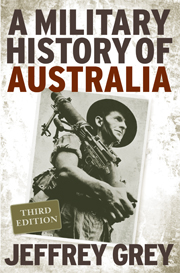Book contents
- Frontmatter
- Contents
- Maps, Tables, Figures and Measurement
- Acknowledgements
- Introduction to the Third Edition
- Introduction to the Second Edition
- 1 The British Period, 1788–1870
- 2 The Military and the Frontier, 1788–1901
- 3 The Colonial Period, 1870–1901
- 4 A New Nation and Its Military Forces, 1901–1914
- 5 The Great War, 1914–1918
- 6 The Inter-war Years, 1919–1939
- 7 The Second World War, 1939–1941
- 8 The Second World War, 1942–1945
- 9 The Postwar Challenge, 1945–1955
- 10 The Wars of Diplomacy, 1955–1972
- 11 From Cold War to Global War on Terror, 1972–
- Appendix 1 Chronological List of Chiefs of Staff of the Armed Forces
- Appendix 2 The Armed Forces: Strength and Expenditure
- Select and Annotated Bibliography
- Index
Introduction to the Second Edition
Published online by Cambridge University Press: 22 September 2009
- Frontmatter
- Contents
- Maps, Tables, Figures and Measurement
- Acknowledgements
- Introduction to the Third Edition
- Introduction to the Second Edition
- 1 The British Period, 1788–1870
- 2 The Military and the Frontier, 1788–1901
- 3 The Colonial Period, 1870–1901
- 4 A New Nation and Its Military Forces, 1901–1914
- 5 The Great War, 1914–1918
- 6 The Inter-war Years, 1919–1939
- 7 The Second World War, 1939–1941
- 8 The Second World War, 1942–1945
- 9 The Postwar Challenge, 1945–1955
- 10 The Wars of Diplomacy, 1955–1972
- 11 From Cold War to Global War on Terror, 1972–
- Appendix 1 Chronological List of Chiefs of Staff of the Armed Forces
- Appendix 2 The Armed Forces: Strength and Expenditure
- Select and Annotated Bibliography
- Index
Summary
Australians do not generally think of themselves as a military people. Our heroes play at full-forward or scrum-half or open the batting, and when we do acknowledge the heroic qualities of someone in a military uniform it is more likely to be for self-sacrificial mateship than deeds of martial virtue. We have statues in the national capital to Simpson and the donkey and to ‘Weary’ Dunlop, both of them symbols of suffering and its alleviation, but none to Albert Jacka, the first Australian to win the Victoria Cross at Gallipoli for single-handedly holding a trench against a Turkish raiding party. Yet in his day Jacka was as great a public figure as Dunlop became in more recent times, and his funeral in Melbourne was attended by thousands, as Dunlop's was. But there, it seems, the similarities end.
Sporting teams and primary produce have not been our only notable exports. In the twentieth century we have been known equally for the quality of our soldiers and our willingness to send them overseas to fight alongside our allies in a variety of causes. At home, we have frequently differed over the necessity to do so, and if the voices raised in dissent have often been in the minority (sometimes distinctly so), in most periods such dissension has been tolerated (though sometimes barely so).
- Type
- Chapter
- Information
- A Military History of Australia , pp. 3 - 6Publisher: Cambridge University PressPrint publication year: 2008



